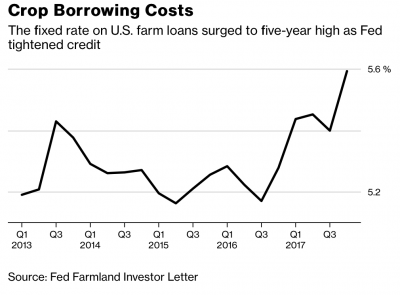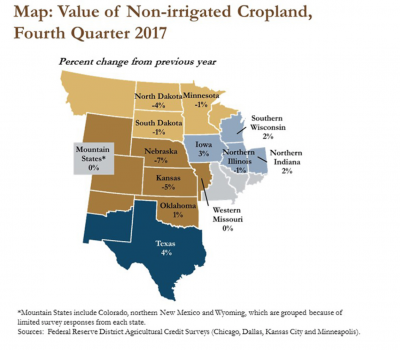Bloomberg's Leah Nylen reported Thursday that "a Colorado judge issued an order temporarily blocking the proposed $25 billion merger of Kroger Co. and Albertsons Cos., which has been challenged by…
Interest Rates on Farm Loans Increase, Pressure on Some Farm Operators Could Follow
Late last month, Bloomberg writer Alan Bjerga reported that, “American farmers have managed to stay afloat despite years of shrinking crop values, the lowest incomes since the recession and a budding trade war with China. Now, they’re feeling a new squeeze — borrowing money is getting more expensive as interest rates rise. For some, it may be fatal.”

The Bloomberg article explained, “The Federal Reserve is tightening credit as the economy shows signs of strength, ending a prolonged period of low interest rates in the wake of the financial crisis. As a result, banks pushed the fixed rate on U.S. farm loans to a five-year high of 5.6 percent in the fourth quarter, up from 5.3 percent a year earlier, Fed data show.
With more increases expected through 2019, farmers may see their thin profit margins evaporate.
The article noted that, “‘It’s going to get difficult as the Fed keeps raising rates,’ said Jerry Catlett, president and chief operating officer of Bruning State Bank in Bruning, Nebraska, about 100 miles southwest of Omaha. Catlett already is factoring in higher debt burdens this year for farmers when assessing their creditworthiness, which means some will get smaller loans or none at all, he said.”

Mr. Bjerga pointed out, “To be sure, lenders don’t expect the U.S. will see a repeat of the widespread bankruptcies that led to the farm crisis in the 1980s. Back then, the industry was hit by interest rates above 15 percent, surging fuel costs, too much debt, slumping commodity prices and a strong dollar that hurt exports.
“Farms tend to be bigger today, and for many older producers, debt is more manageable than three decades ago. While total borrowing will be an estimated $389 billion this year, the ratio of debt to total farm equity remains little changed over the past decade at under 13 percent. It was twice that in the 1980s.”
The Bloomberg article added, “Farmers most at risk in a higher-rate environment will tend to be larger commercial producers who require bigger operating loans, along with younger growers who took on debt during the boom, said Catlett, the Nebraska bank president.”
And on Friday, the Federal Reserve Bank of Kansas City released a paper (“Farm Loan Interest Rates Edge Higher,” by Nathan Kauffman and Ty Kreitman) that stated, “Interest rates on most types of farm loans continued to increase in the first quarter. Following modest increases in benchmark short-term rates, commercial banks raised interest rates on loans used to finance various farm sector purchases (Chart 1).”

The Fed update noted that, “Following historical lows in 2015, interest rates have increased most significantly on loans used to finance operating expenses.
In fact, interest rates on operating loans at commercial banks have increased from a low of 3.5 percent in the fourth quarter of 2015, to 4.9 percent in the first quarter of 2018 (Chart 2).

“In addition to the steady increase in average interest rates, very few loans in the first quarter were made at an interest rate of less than 4 percent. In 2015, more than 40 percent of farm loans used to finance non-real estate purchases were originated with an interest rate of less than 4 percent,” the Fed update said.
Friday’s report also stated, “Higher interest rates also are likely to have placed some downward pressure on the value of farm real estate, which is an important source of collateral for many farm borrowers. Despite the effects of higher interest rates on farm finances, however, nearly half of all new farm real estate loans were originated with fixed interest rates over long time horizons when interest rates were at historical lows several years ago (Chart 6). Thus, interest expenses on many farm real estate loans have remained steady even as interest rates have continued to rise.”

In conclusion, the Kansas City Fed report indicated that, “Interest rates on farm loans have continued to inch higher, but the increases have had a rather modest effect on producers’ overall expenses. Despite the modest increase in interest expenses, higher interest rates typically are expected to place downward pressure on farmland values, which may still have a more significant effect on farm finances than interest expenses directly. Farmland values, however, have continued to remain relatively steady and, even in a higher interest rate environment, have provided ongoing stability to farm sector balance sheets and agricultural lending.”






